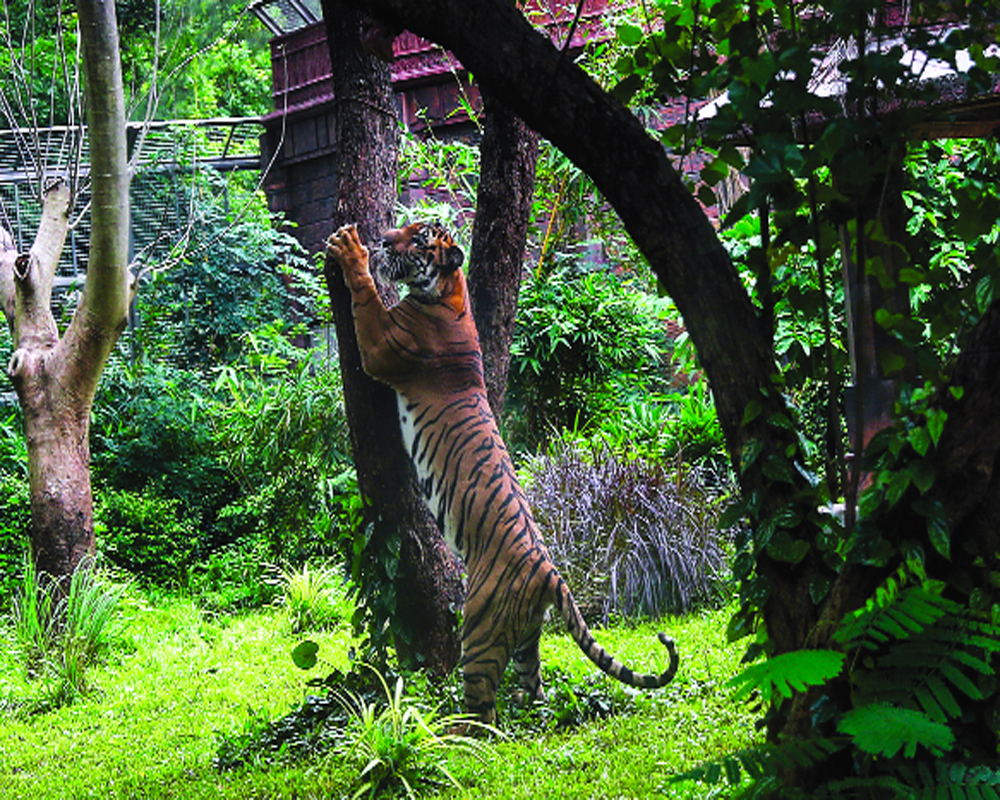MP reports highest 27 tiger deaths, Maha 19 and K’taka 12
At least a dozen or so royal big cats have been dying every month in India, marking a total of 84 mortalities in the first seven months of this year. This includes 14 female cats and 12 cubs.
This is an alarming trend at a time when the country is celebrating the approval of 14 tiger reserves under the Conservation Assured Tiger Standards (CA|TS) scheme.
If this death rate continues unabated, then the numbers are likely to be on the higher side this year compared to the last when around 105 striped felines died.
However, according to NGO Wildlife Protection Society of India (WPSI), 105 endangered species have already died so far since January. Of these, 27 have been poached, as per the WPSI.
An analysis of the data available from the Tigernet, a data based e-platform under the National Tiger Conservation Authority (NTCA), a statutory body under the Union Environment Ministry, shows that some big cats have fallen prey to poachers while many succumbed to infighting. India has 52 tiger reserves spread across 18 States having 2,967 big cats.
The mortality data for 2021 so far also indicates that at least 38 big cats died outside their homes, i.e. tiger reserves, either in man-animal conflict or were killed by poachers. The NTCA has no clue about the death of at least 70 predators so far. At least nine tigers have been poached in the first seven months till July in 2021, raising serious questions about their safety.
State-wise, Madhya Pradesh topped the list with 27 tiger deaths followed by Maharashtra (19). Uttar Pradesh reported seven deaths, Uttarakhand three, Karnataka 12, Kerala 4, Chhattisgarh 2, and five deaths were registered in Assam. One poaching case was reported from Tamil Nadu.
In fact, in the last two months itself, i.e., in June and July, as many as 20 striped cats have died.
In one of the most shocking incidents, a four-year-old pregnant tigress with four fetuses in her womb was brutally killed by unidentified poachers in the Mukutban forest range in Maharashtra.
Most of the deaths in Maharashtra were due to poaching or under mysterious circumstances not proved yet. A tigress died in a wire snare on March 23 in Ghonsa in Maregaon range but forest officials are still clueless.
There have been instances of tigers being mowed down by vehicles too while crossing national highways passing through their habitats or forest areas. For instance, a tiger was killed after being hit by a vehicle while crossing a national highway in Gunghutti range in Madhya Pradesh’s Umaria forest division.
In yet another case, a male Royal Bengal Tiger has died after being hit by a stray bullet fired by forest guards to prevent it from entering human habitations adjacent to the Kaziranga National Park in Assam’s Golaghat district.
Similarly, in January, 2021, in Chandipur a full grown tiger was found dead in Bhadrawati range. The Forest officials suspected it died due to old age. Sources claimed the male tiger was around 14 years old and was not able to hunt properly.
In March, three tiger deaths in three days in a row were reported in Maharashtra. While one tiger was found dead in an irrigation canal of Bor dharan (dam) on March 21, two tigers were found dead on March 23, one in Pandharkawda tahsil of Yavatmal district and another in Nagalwadi range of Pench Tiger Reserve in Nagpur district.
Kedar Gore of The Corbett Foundation says India’s focus has unfortunately been on managing few celebrated tiger reserves.
Conservation Lenses and Wildlife (CLaW), an independent forum of wildlife enthusiasts from Maharashtra, has been documenting the tiger deaths taking place in India.
Sarosh Lodhi, conservation photographer, CLaW said, “Maharashtra and Madhya Pradesh need to pull up their socks for better monitoring, especially in the coming summer season, when the numbers are bound to go up, as is the trend over the years. If Maharashtra accounts for 41% of total tiger mortality in India, it raises some serious questions. MP accounts for 23% which helps us deduce that the problem lies in the Central India landscape, where the total is 25 deaths out of 39 nationally, making it a whopping 64% of the total.”
Wildlife conservationist and director of The Corbett Foundation, Kedar Gore said, “Most of these tiger deaths are near popular tiger reserves and in forest areas adjacent to these reserves, and therefore offer natural dispersal for tigers. Forest corridors are most neglected and lack of sufficient data on tiger presence there only helps poachers. Our focus unfortunately is on managing a few celebrated tiger reserves.”
He also stressed the benefits passed on to the villagers in the buffer zones of tiger reserves and to villagers of other forest areas too to prevent retaliatory killings of wild animals.
The States must receive support from NTCA by way of funds for implementing these human welfare schemes that aid tiger conservation,” he added. Gore also pointed out that fully equipped Tiger Task Forces are still missing in reserves to tackle poachers. Presently, 3,800 tigers are left in the wild in the world.


























